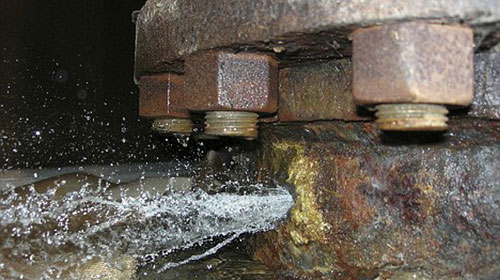Alarms from nuclear power plants in the US: Contaminated water leaks into the environment
The US Congress alarmed that three-quarters of the 65 nuclear power plants in the United States are experiencing radioactive water leaking to the outside environment for a long time, even infiltrating to the aquifer!
>>> 48 US nuclear power plants leak tritium
According to an investigation report by the Government Accountability Office (GAO) of the US Congress, water contaminated with tritium radioisotopes has leaked through rotting pipelines into the environment in 48 of 65 factories. US nuclear power . Meanwhile, power companies operating these plants have yet to find an effective way to detect leaks. Therefore, leaks that have occurred for many years will not stop.

The leak of contaminated water at the Byron Nuclear Power Plant in Illinois in 2007 (Photo: AP)
Radiation is hundreds of times higher than allowed
The concern is that contaminated water from the old and seriously degraded pipeline system of about 37 US nuclear power plants has seeped into the water around the plant. Particularly severe as at the Braidwood Nuclear Power Plant in Illinois, more than 22.7 million liters of tritium-contaminated water leaked into the environment in the 1990s. At the Vermont Yankee Reactor in Vermont State, tritium-contaminated water leaking outside has a level of radioactivity 125 times higher than permitted. At Alabama's Browns Ferry reactor, a 2010 leak leaked into the environment the amount of radioactive water 100 times higher than regulated. The leak in 2008's Quad Cities Factory in Illinois released 375 times the amount of contaminated water.
In many cases, contaminated water polluted a large area. Contaminated water from three nuclear power plants in Illinois and Minnesota polluted clean water wells in the neighborhood, although the level of contamination did not reach the danger threshold. Tritium from a New Jersey nuclear plant leaked and seeped into underground water deep into the ground and escaped into a drainage canal to Barnegat Bay outside the Atlantic.
However, officials from the US Nuclear Energy Institute (NEI) still loudly ensure the impact on public health and the safety of the leak is ' almost zero'. According to the US Environmental Protection Agency (EPA), tritium is a radioactive isotope of hydrogen, with a half-life of about 12.3 years. Tritium is not a highly radioactive isotope, but prolonged exposure to high levels of tritium can lead to cancer, white blood and genetic changes.
According to GAO's report, the US nuclear power industry recently adopted a number of measures to soon detect leaks. However, the US Nuclear Regulation Commission (NRC) is still unable to determine how effective this early detection is when nuclear power plants become increasingly degraded . '
Old factories
The first reactors were built in the 1960s and 1970s. To date, 66 of the 104 reactors have been extended for another 20 years. The government is considering extending the operation of 16 other reactors. A total of 82 reactors have been operating for over 25 years.
Investigations showed that the authorities allowed the reactors to operate in an unsafe way to extend their life. When devices have reached or exceeded safety limits, power companies and authorities are ready to loosen or bend safety regulations. In 2010, the NRC again loosened the limit on radioactive damage to reactors, despite the risk of causing radioactivity to easily fly to the outside environment.
Consequently, nuclear incidents continue to occur. Since 2005, there have been 26 alarms in US nuclear power plants due to the jammed lines, broken devices, contaminated water leaks . For example, on January 22, 2011, a reactor The 39-year-old Michigan driver stopped working because the power cable was broken, blown the fuse, a valve was blocked, causing the reactor to push tritium-containing water vapor into the outside air.
One of the most serious problems is the chemical corrosion of equipment from within the reactors. In 1986, a corroded pipe exploded at the Surry 2 reactor in Virginia, killing four workers. Corrosive chemicals also create cracks in the reactors. From 2001-2003, cracks appeared in reactors in at least 10 nuclear power plants. However, the NRC's answer is always: ' We can fix it. We can replace. We can patch up '. But as a nuclear expert said: 'Everything, including nuclear power plants, exists only for a certain period of time '!
- Japan intends to vaporize contaminated water in Fukushima
- Radioactive leaks at nuclear power plants in France
- Freezing lands around Fukushima factory
- The first floating nuclear power plant will operate in 2016
- 300 tons of contaminated water leaked out
- Nuclear power plant floating on water
- 100 tons of radioactive water leaked at Fukushima
- Japan blocked the leak of contaminated water into the Pacific Ocean
- Germany closed all nuclear power plants by 2022
- Close to the radiation water crisis in Fukushima
- Potential threat from old nuclear plants
- Fukushima leaked contaminated water from the No. 1 storage tank
 Is the magnetic North Pole shift dangerous to humanity?
Is the magnetic North Pole shift dangerous to humanity? Washington legalizes the recycling of human bodies into fertilizer
Washington legalizes the recycling of human bodies into fertilizer Lightning stone - the mysterious guest
Lightning stone - the mysterious guest Stunned by the mysterious sunset, strange appearance
Stunned by the mysterious sunset, strange appearance